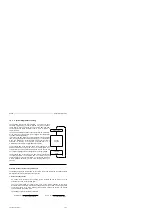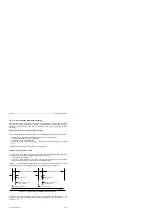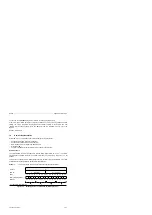
S5-95F
Introduction to STEP 5
7.4.4
Time-Controlled Program Processing
Time-controlled program processing can be defined as a (periodic) time signal causing the CPU to
interrupt cyclic program processing and to process a specific program. Once this program has been
processed, the CPU returns to the point of interruption in the cyclic program and continues
processing.
Prerequisites for Time-Controlled Program Processing
Time-controlled program processing is possible only if the following prerequisites have been fulfilled:
•
The OB13 call-up interval must be programmed larger than 0 ms with COM 95F.
•
Organization block OB13 must be programmed.
•
The S5-95F must be in the RUN mode
•
Interrupt processing must not be disabled by the IA (disable interrupt) operation (see section
8.2.8).
Cyclical program processing continues if OB13 is not programmed.
Periodic Program Processing in OB13
If you use COM95F to program a call-up interval for OB13, then the S5-95F calls OB13 periodically.
The instant for the actual processing of OB13 depends on the following:
•
The call-up interval programmed
•
The delay
t, which depends on the instant of the next synchronization and on the operating
system functions, which are processed in the synchronization routine.
The delay
t is a statistically fluctuating variable. The typical range of fluctuation lies between 0 and
10 ms. Reference values for the maximum OB13 processing delay are given in Table 7-5.
Figure 7-13. Call-Up Interval and Delay of OB13 Processing
t
t
Time t
t
a a a a a a a
a a a a a a a
a a a a a a a
a a a a a a a
a a a a a a a
a a a a a a a
a a a a a a a
a a a a a a a
a a a a a a a
a a a a a a a
a a a a a a a
a a a a a a a
a a a a a a a
a a a a a a a
a a a a a a a
a a a a a a a
a a a a a a a
a a a a a a a
a a a a a a a
a a a a a a a
a a a a a a a
a a a a a a a
a a a a a a a
a a a a a a a
a a a a a a a
a a a a
a a a a
a a a a
a a a a
a a a a
a a a a
a a a a
a a a a
a a a a
a a a a
a a a a
a a a a
a a a a
a a a a
a a a a
a a a a
a a a a
a a a a
a a a a
a a a a
a a a a
a a a a
a a a a
a a a a
a a a a
a a a a a a a a a
a a a a a a a a a
a a a a a a a a a
a a a a a a a a a
a a a a a a a a a
a a a a a a a a a
a a a a a a a a a
a a a a a a a a a
a a a a a a a a a
a a a a a a a a a
a a a a a a a a a
a a a a a a a a a
a a a a a a a a a
a a a a a a a a a
a a a a a a a a a
a a a a a a a a a
a a a a a a a a a
a a a a a a a a a
a a a a a a a a a
a a a a a a a a a
a a a a a a a a a
a a a a a a a a a
a a a a a a a a a
a a a a a a a a a
S5-95F processes the first
statement in OB13
OB13 processing
delay
OB13 processing
delay
OB13 time has elapsed
OB13 time has elapsed
S5-95F processes the first
statement in OB13
OB13call-up interval T
OB13
OB13call-up interval T
OB13
In the ideal case, OB13 is processed directly when the previous OB13 time has elapsed (
t = 0).
Figure 7-13 shows that the interval between two OB13 processings can be between T
OB13
-
t
max
and T
OB13
+
t
max
.
EWA 4NEB 812 6210-02
7-25
















































